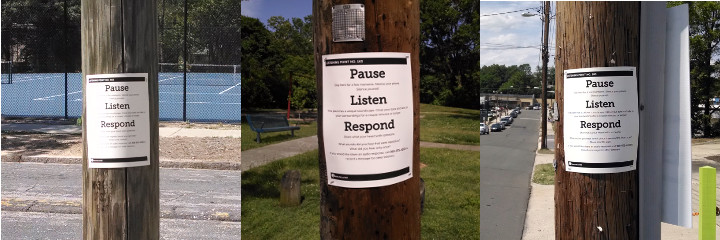In the weeks immediately after its initial launch and early publicity, I tried to keep pace with the Listening Point project by rolling out a new map of listening points in Durham, creating a template for blank listening point signs and phone-based listening point registration system, and holding events for listeners who were interested in connecting with each other.
The project, as it now stands, matches very closely my initial vision of a framework for inviting casual observers to engage more deeply with place through sound and to share their exeriences. Soon, I’ll write more about how I am refining that vision in the project’s next iteration. For now, I wanted to reflect on three unexpected stories from three separate listeners.
The fallen sign
In some locations, listening point signs are taken down quite quickly. Overall, they seem to have a lifespan of about 1-6 weeks, though most disappear sometime in week 2 or 3. Made of cardstock and attached firmly to a surface, they aren’t likely to fall due to natural forces. It surprised me at first to see the signs go missing, given that they’re so inoffensive and more-or-less non-political. But in their attempt to tune passers-by into their invisible soundscapes, they are contributing to the visual noise of the landscape. There’s a clear trade-off here; you can imagine which side I privilege, and my working hypothesis is that the signs are removed by well-meaning folks who prefer a “quieter” visual environment than I do.
I’ve adjusted my own expectations about the very temporary nature of these signs, so I was not surprised to find last week that a sign I had posted along the Museum of Life and Science loop near Rock Quarry Park had vanished. I had hoped this particular sign would last longer, though, because its soundscape was particularly intriguing: surrounded by a small pocket of pine forest, its immediate area was very quiet and still, but lounder sounds from the nearby museum and birds calling from the larger surrounding deciduous forest filtered through the trees and echoed between the gentle hills. Against this subtle background of far-off sounds from sources unseen, the louder, clicking-clacking-whistling sound of a small train would pass by, only several feet away, as the museum’s train took visitors on a loop around its grounds.
Perhaps it was for the best, I thought, that this sign should disappear. After all, it was nearly the only signage of any sort along this quiet trail through the woods. I don’t particularly want to be in the business of disrupting others’ experiences with nature, after all.
But when I continued down the path, I found the missing sign. It was propped up against the base of a tree not far from where it was originally posted. The fact that it was right-side up, clearly visible along the trail, and leaning upright against the trunk of a tree led me to believe that it had been purposefully placed there by someone.
In this action, I see a certain kind of engagement and stewardship over this project. Someone, perhaps discovering that the sign had been removed or blown down from its place on a chain-link fence, decided that the listening experience in this place was valuable enough to find a new home for the sign.
I continued along the trail with a big smile on my face. This was better than simply discovering that the sign was exactly where I had left it!
Read part two in this series of stories: The Lion’s Roar.
